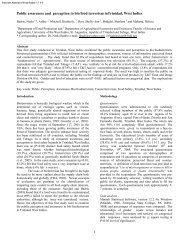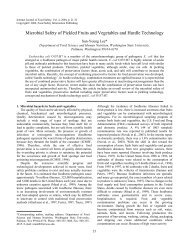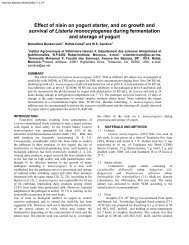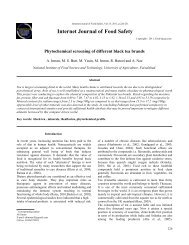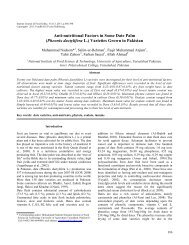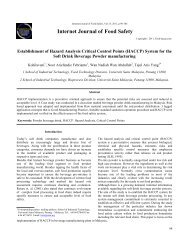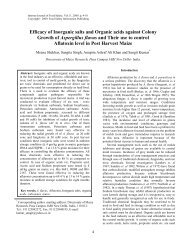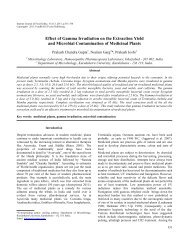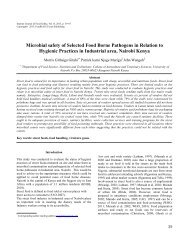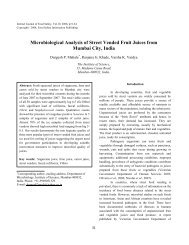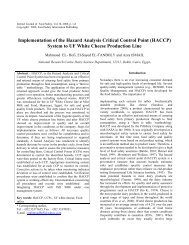Studies on Proliferation of Acetic Acid Bacteria during Soursop
Studies on Proliferation of Acetic Acid Bacteria during Soursop
Studies on Proliferation of Acetic Acid Bacteria during Soursop
Create successful ePaper yourself
Turn your PDF publications into a flip-book with our unique Google optimized e-Paper software.
Internet Journal <strong>of</strong> Food Safety, Vol.13, 2011, p.345-350<br />
Copyright© 2011, FoodHACCP.com Publishing<br />
<str<strong>on</strong>g>Studies</str<strong>on</strong>g> <strong>on</strong> Proliferati<strong>on</strong> <strong>of</strong> <strong>Acetic</strong> <strong>Acid</strong> <strong>Bacteria</strong><br />
<strong>during</strong> <strong>Soursop</strong> Juice Fermentai<strong>on</strong><br />
Sunday P. Ukwo* 1 , Chidi F. Ezeama 2<br />
1. Department <strong>of</strong> Food Science and Technology University <strong>of</strong> Mkar, Gboko, Benue State<br />
2. Department <strong>of</strong> Food Science and Technology Michael Okpara University <strong>of</strong> Agriculture Umudike,<br />
Abia State, Nigeria<br />
Abstract<br />
A study was c<strong>on</strong>ducted to investigate the proliferati<strong>on</strong> <strong>of</strong> acetic acid bacteria <strong>during</strong> various stages <strong>of</strong> soursop juice<br />
fermentati<strong>on</strong>. Preliminary experiment was carried out to identify the genera and species <strong>of</strong> acetic acid bacteria associated<br />
with soursop fruits. The effect <strong>of</strong> pH, temperature and momentary aerati<strong>on</strong> <strong>on</strong> the growth <strong>of</strong> acetic acid bacteria and its effect<br />
<strong>on</strong> the growth <strong>of</strong> Saccharomyces cerevisiae were studied. <strong>Soursop</strong> juice undergoing sp<strong>on</strong>taneous fermentati<strong>on</strong> was m<strong>on</strong>itored<br />
for 10 days. Results showed that acetic acid bacteria were present at all stages <strong>of</strong> fermentati<strong>on</strong>. A successi<strong>on</strong> <strong>of</strong> acetic acid<br />
bacteria indicated that Gluc<strong>on</strong>obacter oxydan was found to be associated with unspoiled fruit and at the early stage <strong>of</strong><br />
fermentati<strong>on</strong>. Acetobacter aceti was prevalent throughout fermentati<strong>on</strong> days while the presence <strong>of</strong> Acetobacter pasteurianus<br />
was noted at the later stage <strong>of</strong> fermentati<strong>on</strong>. These species exhibited rapid growth <strong>on</strong> short exposure <strong>of</strong> the fermenting vessel<br />
to atmospheric oxygen which resulted in a str<strong>on</strong>g correlati<strong>on</strong> between the growth <strong>of</strong> acetic acid bacteria and c<strong>on</strong>centrati<strong>on</strong> <strong>of</strong><br />
acetic acid in the fermenting sample. Higher temperature and elevated pH favoured the growth and metabolism <strong>of</strong> acetic<br />
acid bacteria. There was a reducti<strong>on</strong> in maximal cell c<strong>on</strong>centrati<strong>on</strong> <strong>of</strong> Saccharomyces cerevisiae inoculated with Acetobacter<br />
aceti as compared to species not treated with the bacteria.<br />
Key words: Fermentati<strong>on</strong>, <strong>Soursop</strong> juice, Aceti acid bacteria.<br />
Introducti<strong>on</strong><br />
Fermentati<strong>on</strong> is an energy regenerating metabolic process<br />
<strong>of</strong> which degradati<strong>on</strong> products <strong>of</strong> organic substrates serve<br />
as hydrogen d<strong>on</strong>or as well as hydrogen acceptor. It is a<br />
step-wise process initiated and c<strong>on</strong>trolled by yeasts,<br />
bacteria or an exogenous enzymes. Schlegel (2002) noted<br />
that when the process proceed in the presence <strong>of</strong> oxygen it<br />
is regarded as oxidative fermentati<strong>on</strong> and the end-products<br />
include alcohols, organic acids such as acetate, gluc<strong>on</strong>ate,<br />
keto acid etc. which is accompanied by gradual decrease in<br />
pH. According to Zehnder, (1998) the acetic acid bacteria<br />
share the ability to form acids by incomplete oxidati<strong>on</strong> <strong>of</strong><br />
sugars or alcohols and to excrete these acids either<br />
transiently or into the medium as n<strong>on</strong>-utilizable products.<br />
Battcock and Azam-Ali (1998) noted that yeasts and acetic<br />
acid bacteria exist together in form <strong>of</strong> commensalism<br />
<strong>during</strong> fermentati<strong>on</strong> <strong>of</strong> fruit juices. He asserted that acetic<br />
acid bacteria have the potential to influence the<br />
performance <strong>of</strong> yeast at various stages <strong>of</strong> fermentati<strong>on</strong><br />
* Corresp<strong>on</strong>ding author:<br />
Tel: +2348065168804 e-mail sunnyukwo@yahoo.com<br />
process vis-à-vis the final products.<br />
<strong>Acetic</strong> acid bacteria include gram-negative rods with<br />
limited motility by virtue <strong>of</strong> peritrichous (Acetobacter) or<br />
polar (Gluc<strong>on</strong>obacter) flagellati<strong>on</strong>. The natural habitat <strong>of</strong><br />
acetic acid bacteria are plants and whenever sugar<br />
c<strong>on</strong>taining sap or secreti<strong>on</strong>s occur. <strong>Acetic</strong> acid bacteria can<br />
be found in associati<strong>on</strong> with yeasts (Schlegel, 2002). Their<br />
ability to efficiently c<strong>on</strong>vert ethanol through acetaldehyde<br />
to acetic acid is utilised in culinary and medical vinegar<br />
producti<strong>on</strong>. However in the wine industry this capability<br />
c<strong>on</strong>stitutes spoilage (Fleet, 1993). Wines spoiled by acetic<br />
acid bacteria have characteristic volatility, a vinegar-like<br />
sourness <strong>on</strong> the palate and a range <strong>of</strong> acetic acid aromas<br />
which is <strong>of</strong>ten a reducti<strong>on</strong> in fruity characters. (Bartowsky<br />
et al; 2003). Such wines have low commercial value.<br />
However, this can be improved by blending or treatment by<br />
a reverse-osmotic process to lower acetic acid c<strong>on</strong>tent.<br />
In recent years, researchers have shown c<strong>on</strong>cerned about<br />
the increased levels <strong>of</strong> acetic acid encountered <strong>during</strong><br />
fermentati<strong>on</strong> <strong>of</strong> fruit juice and this has provided the basis <strong>of</strong><br />
this study. The objective <strong>of</strong> this work is to study the<br />
proliferati<strong>on</strong> <strong>of</strong> acetic acid bacteria <strong>during</strong> different stages<br />
345
<strong>of</strong> soursop juice fermentati<strong>on</strong>. The relati<strong>on</strong>ship between<br />
growth <strong>of</strong> acetic acid bacteria and the formati<strong>on</strong> <strong>of</strong> acetic<br />
acid <strong>during</strong> fermentati<strong>on</strong> and the impact <strong>of</strong> Acetobacter<br />
aceti <strong>on</strong> the growth Saccharomyces cerevisiae <strong>during</strong><br />
fermentati<strong>on</strong> <strong>of</strong> soursop juice is also investigated.<br />
Material and Methods<br />
Sample Preparati<strong>on</strong>. Fresh and fully ripe soursop (Ann<strong>on</strong>a<br />
muricata L.) fruit were aseptically harvested from the plant.<br />
Under a sterile c<strong>on</strong>diti<strong>on</strong>, the fruits were hand peeled,<br />
decored and deseeded. The pulp was blended using an<br />
electric blender (Nati<strong>on</strong>al, Model MXN Malaysia). Sterile<br />
water was added in the ratio <strong>of</strong> 1:2 (w/v pulp/water) to<br />
facilitate blending process and make filtrati<strong>on</strong> process<br />
easier. The pulp was filtered using sieve and muslin cloth<br />
under a sterile c<strong>on</strong>diti<strong>on</strong>.<br />
Associati<strong>on</strong> <strong>of</strong> <strong>Acetic</strong> <strong>Acid</strong> <strong>Bacteria</strong> with <strong>Soursop</strong> Fruits.<br />
Preliminary experiment was carried out to identify the<br />
genera and the species <strong>of</strong> acetic acid bacteria prevalent to<br />
fruit juices as outlined Joyeux et al., (1984). <strong>Soursop</strong> fruits<br />
were harvested from different plants depending <strong>on</strong> the level<br />
<strong>of</strong> ripeness.<br />
Isolati<strong>on</strong> and Enumerati<strong>on</strong> <strong>of</strong> <strong>Acetic</strong> and <strong>Bacteria</strong>.<br />
<strong>Acetic</strong> acid bacteria were selectively isolated by seeding<br />
0.1ml <strong>of</strong> the sample <strong>on</strong> glucose-yeast extract agar<br />
c<strong>on</strong>taining glucose (BDH) England 100g/l, yeast extract<br />
10g/l, CaCO3 20g/l and agar 20g/l. The plates were<br />
inverted and incubated aerobically at room temperature for<br />
2-3 days (Hommel and Ahnert 1999) after 3 days isolate<br />
were randomly picked with loop and subcultured for<br />
purificati<strong>on</strong> using glucose. Yeast extract agar c<strong>on</strong>taining<br />
1.0% D-glucose, 0.5% ethanol, 0.3% acetic acid, 1.5%<br />
Bactopept<strong>on</strong>e, 0.8% yeast extract and 0.3% agar. The<br />
medium was fortified withy 0.1ml <strong>of</strong> 0.5% Pimaricin<br />
soluti<strong>on</strong> to inhibit the growth <strong>of</strong> yeasts and mould while<br />
0.1ml <strong>of</strong> 0.25% penicillin soluti<strong>on</strong> was added to inhibit the<br />
growth <strong>of</strong> lactic acid bacteria. The pH <strong>of</strong> the medium was<br />
adjusted to 3.4 using citric acid and the plates were<br />
inculated at 250C for 4 to 8 days after purificati<strong>on</strong><br />
(Lisdiyanti et al, 2001). Distinct col<strong>on</strong>ies based <strong>on</strong> col<strong>on</strong>ial<br />
morphology were purified to obtain pure cultures that were<br />
subjected to routine biochemical tests. The isolates were<br />
then identified according to the scheme <strong>of</strong> Buchanan and<br />
Gibb<strong>on</strong>s (1974). The c<strong>on</strong>centrati<strong>on</strong> <strong>of</strong> acetic acid, lactic<br />
acid and citric acid as well as glucose c<strong>on</strong>centrati<strong>on</strong> were<br />
determined by methods outlined by James (1995).<br />
Growth <strong>of</strong> <strong>Acetic</strong> <strong>Acid</strong> <strong>Bacteria</strong> <strong>on</strong> <strong>Soursop</strong> Juice <strong>during</strong><br />
Fermentati<strong>on</strong>. To investigate the proliferati<strong>on</strong> <strong>of</strong> acetic<br />
acid bacteria at different stages fermentati<strong>on</strong>, samples were<br />
taken <strong>on</strong> the, 0 2nd, 4th, 6th, 8th and 10th days <strong>of</strong><br />
fermentati<strong>on</strong> for analysis. The method outlined by Joyeux et<br />
al (1984) was adopted. The levels and species <strong>of</strong> acetic acid<br />
bacteria found at different stages <strong>of</strong> fermentati<strong>on</strong> were<br />
recorded.<br />
Growth <strong>of</strong> <strong>Acetic</strong> <strong>Acid</strong> <strong>Bacteria</strong> and <strong>Acetic</strong> <strong>Acid</strong><br />
Formati<strong>on</strong>. The relati<strong>on</strong>ship between the growth the acetic<br />
acid bacteria and the formati<strong>on</strong> <strong>of</strong> acetic acid <strong>during</strong><br />
fermentati<strong>on</strong> <strong>of</strong> soursop juice was determined. The method<br />
outlined by Joyeux et al., (1984) was adopted with minor<br />
modificati<strong>on</strong>. 50ml <strong>of</strong> the fermenting sample at pH 3.5,<br />
ethanol 10% was taken and incubated at 100ml c<strong>on</strong>ical<br />
flask at 190C to provide for aerobic c<strong>on</strong>diti<strong>on</strong>. Growth <strong>of</strong><br />
acetic acid bacteria was determined by plate count<br />
technique (Lisdiyanti et al., 2001) while acetic acid<br />
producti<strong>on</strong> was determined by method outlined by James<br />
(1995).<br />
Effects <strong>of</strong> pH, Temperature and Momentary Aerati<strong>on</strong><br />
<strong>on</strong> Growth <strong>of</strong> <strong>Acetic</strong> <strong>Acid</strong> <strong>Bacteria</strong>. The effects <strong>of</strong> pH,<br />
temperature and momentary aerati<strong>on</strong> <strong>on</strong> acetic acid bacteria<br />
growth were determined by taking the fermenting samples<br />
<strong>on</strong> the first day <strong>of</strong> fermentati<strong>on</strong>, adjusted the pH to 3.7, 4.1<br />
and stored at 100C or 180C. The samples were stored at<br />
100ml completely filled c<strong>on</strong>ical flask to yield an anaerobic<br />
envir<strong>on</strong>ment. After 4 days <strong>of</strong> storage, the c<strong>on</strong>tents <strong>of</strong> the<br />
flasks were exposed to air for 3 mins by pouring them into<br />
the beakers and returning it to the flasks. Analysis was d<strong>on</strong>e<br />
3 days after this aerati<strong>on</strong> (Zoecklein et al., 1989).<br />
Impact <strong>of</strong> <strong>Acetic</strong> <strong>Acid</strong> <strong>Bacteria</strong> <strong>on</strong> the growth <strong>of</strong><br />
Saccharomyces cerevisiae <strong>during</strong> fermentati<strong>on</strong>.<br />
Experiment was carried out to investigate the effect <strong>of</strong><br />
acetic acid bacteria <strong>on</strong> the growth <strong>of</strong> Saccharomyces<br />
cereivisiae <strong>during</strong> fermentati<strong>on</strong> <strong>of</strong> soursop juice. Freshly<br />
prepared soursop juice was pasteurized at 650C for 30 mins<br />
and allowed to cool. Acetobacter aceti and Saccharomyces<br />
cerevisiae were simultaneously inoculated in the juice<br />
(Jussier et al., 2006). The growth <strong>of</strong> Saccharomyces<br />
cerevisiae was determined by plate count technique as<br />
outlined by Kapsopoulou et al., (2005).<br />
Results<br />
Identificati<strong>on</strong> and differentiati<strong>on</strong> <strong>of</strong> acetic acid bacteria<br />
strains. The major distinguishing features between<br />
Acetobacter and Gluc<strong>on</strong>obacter is the ability to oxidise<br />
acetic acid to CO2. Acetobacter species are able to oxidise<br />
ethanol to acetic acid and then to CO2 and H2O whereas<br />
Gluc<strong>on</strong>obacter species do not have a complete citric acid<br />
cycle and cannot oxidise ethanol further than acetic acid.<br />
Gluc<strong>on</strong>obacters are sometimes referred to as underoxidisers<br />
while Acetobacters are overoxidisers, because <strong>of</strong><br />
their difference in oxidative potential. <strong>Acetic</strong> acid bacteria<br />
have been successfully identified to genus and species<br />
levels according to an array <strong>of</strong> morphological physiological<br />
and biochemical tests as shown in table 1 and 2 below:<br />
346
Table1. Distinguishing AAB genera<br />
Acetobacter<br />
Gluc<strong>on</strong>obacter<br />
Motility and flagellati<strong>on</strong> Peritrichous/n<strong>on</strong> motile Polar/n<strong>on</strong> motile<br />
Oxidati<strong>on</strong> <strong>of</strong> ethanol to acetic acid + +<br />
Oxidati<strong>on</strong> <strong>of</strong> acetic acid to CO 2 and H 2 O + -<br />
Oxidati<strong>on</strong> <strong>of</strong> lactate to CO 2 and H 2 O + -<br />
Growth <strong>on</strong> 0.35% acetic acid medium + +<br />
Growth <strong>on</strong> 30% glucose medium - -<br />
<strong>Acid</strong> producti<strong>on</strong> from glycerol + +<br />
<strong>Acid</strong> producti<strong>on</strong> from mannatol - -<br />
<strong>Acid</strong> producti<strong>on</strong> from Raffinose - -<br />
Table 2. Distinguishing <strong>Acetic</strong> acid bacteria isolates<br />
Acetobacter<br />
Gluc<strong>on</strong>obacter<br />
aceti pasteurianus tropicalis oxydans<br />
Growth <strong>on</strong> carb<strong>on</strong> sources<br />
Glycerol + + + +<br />
Ethanol + Variable - +<br />
Sodium acetate + + - Variable<br />
<strong>Acid</strong> producti<strong>on</strong> from<br />
D-glucose + + Variable +<br />
D-mannose + - - +<br />
D-galactose + Variable - +<br />
D-xylose + + - -<br />
Ketogenesis from<br />
Glycerol + - - +<br />
Sorbutol + - +<br />
Mannitol Variable - - +<br />
Formati<strong>on</strong> from D-glucose <strong>of</strong><br />
2-keto-D-gluc<strong>on</strong>ic acid + Variable + +<br />
5-keto-D-gluc<strong>on</strong>ic acid + - - +<br />
Nitrate reducti<strong>on</strong> - + +<br />
- = negative<br />
+ = positive<br />
Variable = 11-89% <strong>of</strong> strains positive<br />
Table 3. Occurrence <strong>of</strong> Aceti acid bacteria <strong>during</strong><br />
Associati<strong>on</strong> <strong>of</strong> <strong>Acetic</strong> <strong>Acid</strong> <strong>Bacteria</strong> with <strong>Soursop</strong> Fruits fermentati<strong>on</strong> <strong>of</strong> soursop juice<br />
<str<strong>on</strong>g>Studies</str<strong>on</strong>g> were c<strong>on</strong>ducted with soursop fruits harvested from<br />
<strong>Acetic</strong><br />
different plantati<strong>on</strong>s in Uyo Southern Nigeria. It shows that<br />
acid<br />
Fermentati<strong>on</strong><br />
Micro organism<br />
the density <strong>of</strong> acetic acid bacterial was always found to be<br />
bacteria<br />
Time (days)<br />
(%)<br />
linked to the degree <strong>of</strong> ripeness <strong>of</strong> the fruit. Freshly<br />
(cfu/ml)<br />
extracted juice from the soursop fruits at the early harvest<br />
c<strong>on</strong>tain an average 102cfu/ml <strong>of</strong> acetic acid bacteria.<br />
0<br />
(x10 4 )<br />
1640 G. oxydans 90, A. aceti 10<br />
The level <strong>of</strong> acetic acid bacteria increase <strong>during</strong> storage<br />
2 120 G. oxydans 50, A. aceti 50<br />
from 105 to 107cfu/ml and keep <strong>on</strong> increasing as the fruit<br />
4 100 A. aceti 80, G. oxydans 10<br />
got spoilt. Gluc<strong>on</strong>obacter oxydan was the acetic acid<br />
A. pasteurianus 10<br />
bacteria found <strong>on</strong> sound, unspoiled soursop fruits.<br />
6 80 A. aceti 50, A. pasteurianus50<br />
8 50 A. pasteuranus 60, A. aceti 40<br />
Acetobacter aceti became more prevalent as the fruit<br />
10 40 A. pasteuranus 80, A. aceti 20<br />
became spoiled. These two species accounted for 75-85%<br />
* Values are means from 3 determinati<strong>on</strong>s<br />
acetic acid bacteria found <strong>on</strong> the harvested soursop fruits.<br />
Growth <strong>of</strong> <strong>Acetic</strong> <strong>Acid</strong> <strong>Bacteria</strong> <strong>on</strong> <strong>Soursop</strong> Juice <strong>during</strong><br />
Freshly prepared soursop juice c<strong>on</strong>tain 90% <strong>of</strong> G. oxydans.<br />
Fermentati<strong>on</strong>. The levels and species <strong>of</strong> acetic acid<br />
The populati<strong>on</strong> progressively decreased <strong>during</strong> alcoholic<br />
bacteria found at different stages <strong>of</strong> fermentati<strong>on</strong> <strong>of</strong> soursop<br />
fermentati<strong>on</strong>, and at the end <strong>of</strong> fermentati<strong>on</strong> (10th day) no<br />
juice are represented in the Table below:<br />
col<strong>on</strong>y <strong>of</strong> G. oxydans was detected. Also, Acetobacter aceti<br />
347
was dominant all through the fermentati<strong>on</strong> days as it rose<br />
from 10% in the freshly prepared juice to the peak at the 4th<br />
day <strong>of</strong> fermentati<strong>on</strong> and fall to 20% at the 10th day <strong>of</strong><br />
fermentati<strong>on</strong>. A. pasteuranus was also seen to be present<br />
<strong>during</strong> the late stages <strong>of</strong> fermentati<strong>on</strong> from the 4th day to<br />
10th day <strong>of</strong> fermentati<strong>on</strong>.<br />
Growth <strong>of</strong> <strong>Acetic</strong> <strong>Acid</strong> <strong>Bacteria</strong> and <strong>Acetic</strong> <strong>Acid</strong><br />
formati<strong>on</strong>. The relati<strong>on</strong>ship between the growth <strong>of</strong> acetic<br />
acid bacteria and the formati<strong>on</strong> <strong>of</strong> acetic acid <strong>during</strong><br />
fermentati<strong>on</strong> was investigated. At the bacteria counts<br />
c<strong>on</strong>sisting <strong>of</strong> mixed populati<strong>on</strong> <strong>of</strong> A. aceti and A.<br />
pasteuranus progressively increased from the initial level <strong>of</strong><br />
3.0 x 104cfu/ml into 2.3 x 106cfu/ml. At the same time the<br />
c<strong>on</strong>centrati<strong>on</strong> <strong>of</strong> acetic acid in the wine increased from<br />
0.72g/l to 2.10g/l. While the level <strong>of</strong> lactic acid did not<br />
change. It was also noted that between the sec<strong>on</strong>d and third<br />
day <strong>of</strong> incubati<strong>on</strong>, 100mg <strong>of</strong> acetic per litre was produced<br />
although the bacteria populati<strong>on</strong> increased <strong>on</strong>ly from 6.8 x<br />
102 to 9.8 x 102 cfu/ml.<br />
Effect <strong>of</strong> pH, Temperature and Momentary Aerati<strong>on</strong> <strong>on</strong><br />
Growth <strong>of</strong> <strong>Acetic</strong> <strong>Acid</strong> <strong>Bacteria</strong>. The result showed<br />
samples stored in a completely anaerobic c<strong>on</strong>diti<strong>on</strong> for both<br />
temperature (10 and 180C). It indicated that the growth <strong>of</strong><br />
acetic acid bacteria decreased more rapidly at pH 3.7 than at<br />
pH 4.1 while the c<strong>on</strong>centrati<strong>on</strong> <strong>of</strong> acetic acid stayed<br />
c<strong>on</strong>stant. Also 3 days after the momentary aerati<strong>on</strong>, the<br />
result showed little growth at 100C but the number <strong>of</strong> cells<br />
increased by 30-to-40 fold <strong>on</strong> storage at 180C. This was<br />
accompanied by a significant increase in the level <strong>of</strong> acetic<br />
acid. Slightly high counts <strong>of</strong> bacteria were observed at the<br />
higher pH <strong>of</strong> 4.1.Table 4 below summarises the result<br />
Table 4. Effect <strong>of</strong> pH and storage temperature <strong>on</strong><br />
growth <strong>of</strong> acetic acid bacteria and c<strong>on</strong>centrati<strong>on</strong> <strong>of</strong><br />
acetic acid after aerati<strong>on</strong><br />
Storage temp.<br />
( 0 C)<br />
pH<br />
<strong>Acetic</strong> acid<br />
bacteria<br />
(cfu/ml)<br />
<strong>Acetic</strong> acid<br />
(mg/l)<br />
10 3.7 2.0 x 10 3 380<br />
10 4.1 2.0 x 10 3 400<br />
18 3.7 2.5 x 10 5 480<br />
18 4.1 3.5 x 10 5 540<br />
* Values are means from 3 determinati<strong>on</strong>s<br />
Impact <strong>of</strong> <strong>Acetic</strong> <strong>Acid</strong> <strong>Bacteria</strong> <strong>on</strong> the growth <strong>of</strong><br />
Saccharomyces cerevisiae. The growth <strong>of</strong> Saccharomyces<br />
cerevisiae inoculated into soursop juice without<br />
Acetobacter aceti was characterized by a very high<br />
c<strong>on</strong>centrati<strong>on</strong> <strong>of</strong> cells which reach its peak at the 4th day<br />
with 3.2 x 108cfu/ml cells (Table 5). This similar result was<br />
observed by Kapsopoulou et al., (2005) <strong>during</strong> his studies<br />
<strong>on</strong> growth and fermentati<strong>on</strong> characteristics <strong>of</strong> wine yeast.<br />
However, the growth <strong>of</strong> Saccharomyces cerevisiae<br />
inoculated al<strong>on</strong>gside Acetobacter aceti was characterized by<br />
lower c<strong>on</strong>centrati<strong>on</strong> <strong>of</strong> cells. The exp<strong>on</strong>ential stage <strong>of</strong><br />
fermentati<strong>on</strong> was not noted but rather a sharp reducti<strong>on</strong> in<br />
yeast count. There was no visible air bubble usually<br />
observed <strong>during</strong> fermentati<strong>on</strong> process.<br />
Table 5. Growth <strong>of</strong> Saccharomyces cerevisiae (Sc)<br />
inoculated into soursop juice with and without<br />
Acetobacter aceti (AAB) <strong>during</strong> fermentati<strong>on</strong> <strong>of</strong> soursop<br />
juice<br />
Yeast count (cfu/ml)<br />
Fermentati<strong>on</strong> Time<br />
(days)<br />
Sc<br />
Sc + AAB<br />
0 3.2 x 10 5 3.2 x 10 5<br />
2 2.0 x 10 6 1.0 x 10 6<br />
4 3.2 x 10 8 2.0 x 10 6<br />
6 1.6 x 10 7 1.6 x 10 6<br />
8 2.0 x 10 6 1.0 x 10 6<br />
10 1.0 x 10 6 3.0 x 10 5<br />
* Values are means from 3 determinati<strong>on</strong>s<br />
Discussi<strong>on</strong><br />
This study has indicated the presence <strong>of</strong> acetic acid bacteria<br />
<strong>during</strong> sp<strong>on</strong>taneous fermentati<strong>on</strong> <strong>of</strong> soursop juice.<br />
Gluc<strong>on</strong>obacter oxydan was acetic acid bacteria found in<br />
sound, unspoiled fruits and also occur at the early stage <strong>of</strong><br />
fermentati<strong>on</strong>. Acetobacter aceti became more prevalent as<br />
the fruit became spoiled and as a major c<strong>on</strong>taminants <strong>during</strong><br />
fermentati<strong>on</strong> <strong>of</strong> soursop juice while Acetobacter<br />
pasteurianus was found at the later stage <strong>of</strong> fermentati<strong>on</strong>.<br />
<strong>Acetic</strong> acid bacteria produced acetic acid through the<br />
metabolism <strong>of</strong> ethanol to acetaldehyde and to acetic acid.<br />
There are two membrane bound enzymes catalysing the<br />
reacti<strong>on</strong>. Firstly alcohol dehydrogenese c<strong>on</strong>vert ethanol to<br />
acetaldehyde and sec<strong>on</strong>dly acetaldehyde dehydrogenese<br />
which c<strong>on</strong>vert acetaldehyde to acetic acid (Adachi et al;<br />
1987). The intermediate metabolite acetaldehyde can<br />
c<strong>on</strong>tribute to the sensory spoilage <strong>of</strong> wine with distinct<br />
aroma. The growth <strong>of</strong> A. pasterianus to 4.0 x 104cfu/ml <strong>on</strong><br />
the 10th day <strong>of</strong> fermentati<strong>on</strong> is an indicati<strong>on</strong> <strong>of</strong> a complete<br />
change in the chemical compositi<strong>on</strong> <strong>of</strong> the fermenting must.<br />
At this stage there is a decrease in ethanol c<strong>on</strong>centrati<strong>on</strong><br />
and a substantial increase in acetic acid c<strong>on</strong>centrati<strong>on</strong>. This<br />
findings c<strong>on</strong>firms the result observed by Bartowsky and<br />
Henschke (2008) in her studies <strong>on</strong> spoilage <strong>of</strong> bottle wine<br />
by acetic acid bacteria.<br />
Fruit juice is despite being a rich medium with high<br />
c<strong>on</strong>centrati<strong>on</strong>s <strong>of</strong> hexoses (glucose and fructose 200-<br />
250g/L) high pH (pH 2.9-3.7) and Titratable acidity (2-<br />
10g/L as tartaric acid) provide a high selective medium for<br />
bacterial growth. Also the very harsh envir<strong>on</strong>ment <strong>of</strong> the<br />
fermenting juice created by high ethanol c<strong>on</strong>centrati<strong>on</strong>, low<br />
oxygen c<strong>on</strong>tent and redox potential, low pH and depleti<strong>on</strong><br />
<strong>of</strong> nutrients, resulting from c<strong>on</strong>sumpti<strong>on</strong> by yeast <strong>during</strong><br />
alcoholic fermentati<strong>on</strong> restricted the growth <strong>of</strong><br />
Gluc<strong>on</strong>obacter oxydans (Drysdale and Fleet, 1985). In the<br />
absence <strong>of</strong> yeast, especially <strong>during</strong> juice preparati<strong>on</strong>, acetic<br />
348
acid bacteria populati<strong>on</strong>s can increase to spoil the juice by<br />
producti<strong>on</strong> <strong>of</strong> acetic acid, but <strong>during</strong> fermentati<strong>on</strong>, the<br />
populati<strong>on</strong> <strong>of</strong> the bacteria tends to decrease and can fall<br />
below 102cfu/ml by the end <strong>of</strong> fermentati<strong>on</strong>. Acetobacter<br />
species are better adapted to the higher ethanol<br />
c<strong>on</strong>centrati<strong>on</strong>s and thus tend to col<strong>on</strong>ised the fermented<br />
juice thereby causing spoilage (Ukwo et al., 2010).<br />
There was a str<strong>on</strong>g correlati<strong>on</strong> between the growth <strong>of</strong> acetic<br />
acid bacteria and the c<strong>on</strong>centrati<strong>on</strong> <strong>of</strong> acetic acid present at<br />
the fermenting sample. Also allowing atmospheric oxygen<br />
into the fermenting vessels resulted in rapid multiplicati<strong>on</strong><br />
<strong>of</strong> these species and c<strong>on</strong>sequently the producti<strong>on</strong> <strong>of</strong> more<br />
acetic acid. This process is particularly favourable at higher<br />
temperature and elevated pH. This has shown that acetic<br />
acid bacteria being strickly aerobic would developed in<br />
wine when the fermenting vessel is partially filled. This<br />
findings agrees with the result obtained by Joyeux et al.,<br />
(1984) where he noted that this could be counter productive<br />
<strong>during</strong> large scale producti<strong>on</strong> <strong>of</strong> wine.<br />
The effect <strong>of</strong> acetic acid bacteria <strong>on</strong> the growth <strong>of</strong><br />
Saccharomyces cerevisiae <strong>during</strong> fermentati<strong>on</strong> <strong>of</strong> soursop<br />
juice resulted in a slow or sluggish fermentati<strong>on</strong>. The<br />
presence <strong>of</strong> these bacteria induced classic symptoms <strong>of</strong> an<br />
incomplete fermentati<strong>on</strong> with high residual sugar, lower<br />
ethanol, reducti<strong>on</strong> in iso-amyl alcohol and glycerol with a<br />
corresp<strong>on</strong>ding increase in the producti<strong>on</strong> <strong>of</strong> acetic acid,<br />
gluc<strong>on</strong>ic acid, acetaldehyde and ethyl acetate (Ukwo et al,<br />
2010). Reports have shown that acetic acid bacteria possess<br />
high oxidative enzymes such as alcohol dehydrogenase and<br />
aldehyde dehydrogenase capable <strong>of</strong> oxidizing alcohol<br />
produce by yeast to acetic acid <strong>during</strong> fermentati<strong>on</strong><br />
(Hommel and Ahnert, 1999). <str<strong>on</strong>g>Studies</str<strong>on</strong>g> has shown acetic acid<br />
have inhibitory effect <strong>on</strong> the growth and metabolism <strong>of</strong><br />
Saccharomyces cerevisiae <strong>during</strong> fermentati<strong>on</strong> (Battcock<br />
and Azam-Ali 1998). Phowchinda et al., (1995) also noted<br />
that acetic acid causes a reducti<strong>on</strong> <strong>of</strong> maximal cell<br />
c<strong>on</strong>centrati<strong>on</strong> <strong>of</strong> Saccharomyces cerevisiae cells <strong>during</strong><br />
fermentati<strong>on</strong>.<br />
According to Pampulla and Loweiro-Dias (1989), the<br />
undissociated acetic acid produced by Acetobacter aceti<br />
diffuses into yeast cells and caused a decrease in the pH <strong>of</strong><br />
cytoplasm thereby inhibiting the activities <strong>of</strong> key enzymes<br />
especially enolase, aldolase, phosphoglyceromutase and<br />
triosephosphate isomarase. This have resulted in the lower<br />
cells <strong>of</strong> Saccharomyces cerevisiae inoculated al<strong>on</strong>gside<br />
acetic acid bacteria.<br />
C<strong>on</strong>clusi<strong>on</strong><br />
This study investigated the occurrence <strong>of</strong> acetic acid<br />
bacteria <strong>during</strong> various stages <strong>of</strong> soursop juice fermentati<strong>on</strong>.<br />
The study dem<strong>on</strong>strated permanent presence <strong>of</strong> acetic acid<br />
bacteria <strong>during</strong> fermentati<strong>on</strong> <strong>of</strong> soursop juice. There were<br />
changes in the type <strong>of</strong> bacteria present at various stages <strong>of</strong><br />
fermentati<strong>on</strong>. Successively, these bacteria are G. oxydan, A.<br />
acetic A. pasteurianus. Only A. aceti was prevalent all<br />
stages <strong>of</strong> fermentati<strong>on</strong>. A higher temperature elevated pH,<br />
and the presence <strong>of</strong> atmospheric oxygen are encouraging<br />
factors for bacteria growth and acetic acid producti<strong>on</strong> which<br />
is counter productive to wine producti<strong>on</strong>. Preventi<strong>on</strong> <strong>of</strong><br />
acetic acid bacteria proliferati<strong>on</strong> is based <strong>on</strong> an<br />
understanding that these bacteria are aerobic in their<br />
physiology and require oxygen for growth. Such growth can<br />
be prevented by practices that include blanketing wine with<br />
an inert gas such as carb<strong>on</strong> (iv) oxide, ensuring that<br />
fermenting c<strong>on</strong>tainers are completing filled with the juice to<br />
minimise c<strong>on</strong>tact with the head space <strong>of</strong> air or oxygen and<br />
by the process <strong>of</strong> sterile filtrati<strong>on</strong> <strong>of</strong> the juice. These will<br />
provide an important tool toward reducing the incidence <strong>of</strong><br />
wine spoilage caused by proliferati<strong>on</strong> acetic acid bacteria<br />
<strong>during</strong> fermentati<strong>on</strong>.<br />
References<br />
Adachi, O., Yayama, K. Shinagawa, K., Matsushita, K.<br />
Ameyama, M. 1987. Purificati<strong>on</strong> and characterisati<strong>on</strong><br />
<strong>of</strong> particulate alcohol dehydrogenage from<br />
Gluc<strong>on</strong>obacter suboxydans. Agricultural and<br />
Biological Chemistry 42, 2045-2056.<br />
Bartowsky, E. J. Henschke, P. A. 2008. <strong>Acetic</strong> acid bacteria<br />
spoilage <strong>of</strong> bottle red wine. A review. Internati<strong>on</strong>al<br />
Journal <strong>of</strong> Food Microbiology 125:60-70.<br />
Bartowsky, E. J. Xia, D., Gibs<strong>on</strong>, R. L. Fleet, R. L.<br />
Henschke, P. A. 2003. Spoilage <strong>of</strong> bottle red wine by<br />
<strong>Acetic</strong> acid bacteria. Letters in Applied Microbiology<br />
36, 307-314.<br />
Battcock, M. and Azam,-Ali (989. Fermenting Fruits and<br />
Vegetables, Global Perspective. Food and Agricultural<br />
Organisati<strong>on</strong> (FAO) Rome Italy. Bulletin No. 134.<br />
Buchanan, R. and Gibb<strong>on</strong>, N. (Ed.) 1974. Bergey’s Manual<br />
<strong>of</strong> determinative bacteriology, 8th Ed. The William<br />
and Wilkin Co., Baltimore.<br />
Drysdale, G.S., Fleet, G.H., 1989. The effect <strong>of</strong> acetic acid<br />
bacteria up<strong>on</strong> the growth and metabolism <strong>of</strong> yeasts<br />
<strong>during</strong> the fermentati<strong>on</strong> <strong>of</strong> grape juice. Journal <strong>of</strong><br />
Applied Bacteriology 67, 471–481.<br />
Fleet G. H. 2003. Yeast interacti<strong>on</strong>s and wine flavour.<br />
Internati<strong>on</strong>al Journal <strong>of</strong> Food Microbiology 86:11-22.<br />
Hommel, R. K. and Ahnert, P. 1999. Acetobacter. In:<br />
Encyclopedia <strong>of</strong> Food Microbiology. Academic Press<br />
Vol. 1. 352-359.<br />
James, C. S. 1995. Analytical Chemistry <strong>of</strong> Foods. Blackie<br />
Academic and Pr<strong>of</strong>essi<strong>on</strong>al, Chapman and Hall<br />
L<strong>on</strong>d<strong>on</strong>. pp. 410-428.<br />
349
Joyeux, A.., Laf<strong>on</strong>-Lafourcade, S. and Ribereau-Gay<strong>on</strong><br />
1984. Evoluti<strong>on</strong> <strong>of</strong> <strong>Acetic</strong> acid bacteria <strong>during</strong><br />
fermentati<strong>on</strong> and storage <strong>of</strong> wine. Applied and<br />
Envir<strong>on</strong>mental Microbiology. 48: (1): 153-159.<br />
Jussier, D. Morneau, A. and Ordura, R. 2006. Effect <strong>of</strong><br />
Simultaneous inoculati<strong>on</strong> with Yeast and <strong>Bacteria</strong> <strong>on</strong><br />
Fermentati<strong>on</strong> Kinetics and key wine parameters <strong>of</strong><br />
cool-climate Chard<strong>on</strong>gy. Applied Envir<strong>on</strong>mental<br />
Microbiology, 72 (1): 221-227.<br />
Kapsopoulou, K. Kapaklis, A. Spyropoulas, H. 2005.<br />
Growth and Fermentati<strong>on</strong> characteristics <strong>of</strong> a strain <strong>of</strong><br />
wine yeast. World Journal <strong>of</strong> Microbiology and<br />
Biotechnology, 21: 1599-1602.<br />
Lisdiyanti, P. Kawagaki, H. Seki, T. Yamada, Y. Uchimura,<br />
T. and Komagata, K. 2001. Identificati<strong>on</strong> <strong>of</strong><br />
Acetobacter strain from Ind<strong>on</strong>esia Sources. Journal <strong>of</strong><br />
General and Applied Microbiology, 47: 119-131.<br />
Pampulla, M. and Loureiro-Das 1989. Interacti<strong>on</strong> <strong>of</strong> the<br />
effect <strong>of</strong> acetic acid and ethanol <strong>on</strong> inhibiti<strong>on</strong> <strong>of</strong><br />
fermentati<strong>on</strong> in Saccharomyces cerevisiae.<br />
Biotechnology Letters, 11: 269-274.<br />
Phowchinda, V. Delia-Dupuy, M. L. and Strechaiano, P.<br />
1995. Effect <strong>of</strong> <strong>Acetic</strong> acid <strong>on</strong> growth and<br />
Fermentative activity <strong>of</strong> Saccharomyces cerevisiae.<br />
Biotechnology Letters, 17 (2): 237-242.<br />
Schlegel, H. G. 2002. Incomplete Oxidati<strong>on</strong>s and Microbial<br />
biotechnology. In: General Microbiology, 7th Editi<strong>on</strong><br />
Cambridge University Press. pp.290-360.<br />
Ukwo, S. P. Ezeama, C. F. and Ndaeyo, N. U. 2010.<br />
Growth <strong>of</strong> Different Yeast strain <strong>during</strong> fermentati<strong>on</strong><br />
<strong>of</strong> soursop (Ann<strong>on</strong>a muricata) Juice as influence by<br />
<strong>Acetic</strong> <strong>Acid</strong> <strong>Bacteria</strong>. Nature and Science, 8 (10): 285-<br />
291.<br />
Zehnder, A. B. 1998. Biology <strong>of</strong> Anaerobic Microorganism,<br />
New York, Wiley Producti<strong>on</strong>.<br />
Zoecklein, B. W., Fugelsang, K. C., Gump, B. H. and Hury,<br />
F. S. 1989. Sampling Fermentati<strong>on</strong> and Producti<strong>on</strong><br />
Analysis, In: Zoeuclecir B. W. Fugelsang, K. C. Gump,<br />
B. H. Nury, F. S. (Eds.). Producti<strong>on</strong> wine analysis.<br />
Van Nostrand Reinhold, New York. pp. 91-181.<br />
350



